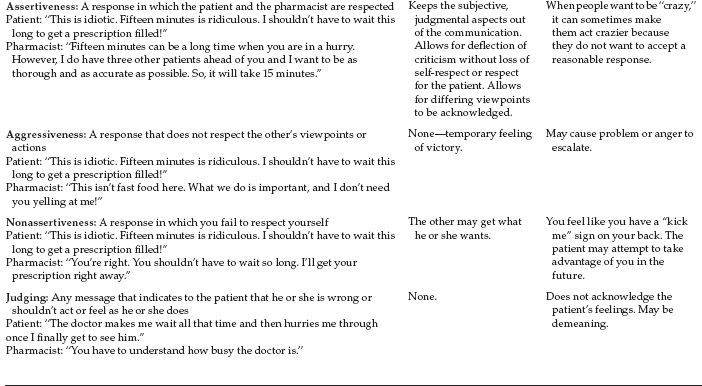
Example 1
![]() Patient: You and my doctor are only interested in getting my money.
Patient: You and my doctor are only interested in getting my money.
Pharmacist: You are angry because it seems like your doctor and I care more about your money than about you.
Example 2
![]() Patient: I just found out I have diabetes. I knew something was wrong.
Patient: I just found out I have diabetes. I knew something was wrong.
Pharmacist: You knew something was wrong, but you weren’t prepared to find out you have diabetes. This worries you.
REASSURANCE
A reassuring response attempts to make someone feel better, relieved, less frightened, or more confident. Although such responses are attempts to help or care, they are often motivated by the anxiety of the person providing them. That is, one person says something that indicates he or she feels frightened or overwhelmed. The other person gives a reassuring response (“Don’t worry, it’ll be OK”) in an attempt to relieve his or her own anxiety about not knowing how to help or alleviate the problem. Reassuring responses work best when the other person asks for reassurance. They can backfire when the person does not ask for reassurance and really just wants to be understood. The following two examples should help clarify this.
Example 1
![]() Patient: Have other patients told you they were afraid to give themselves allergy shots?
Patient: Have other patients told you they were afraid to give themselves allergy shots?
Pharmacist: They sure have. I feel confident that, like other patients, you’ll have no problem with it after some practice. I’ll be glad to show you how to do it.
Patient: Great. I’d like that. Thanks.
Reassurance worked here because the patient asked for it. The patient did not want to feel alone in her fear, so she asked if other patients had this problem. She needed reassurance that she was not alone in being afraid.
Example 2
![]() Patient: I just feel so overwhelmed. I finally get my blood pressure under control and now I find out I have asthma. What next?
Patient: I just feel so overwhelmed. I finally get my blood pressure under control and now I find out I have asthma. What next?
Pharmacist: Mrs. Smith, it’s not so bad. Asthma can be controlled. You’ll be OK.
Patient: What do you mean, it’s not so bad? Do you have high blood pressure? Do you have asthma? It’s easy for you to stand there and say it’s not so bad!
Pharmacist: Calm down. It’s going to be all right.
Patient: Don’t tell me to calm down! This isn’t happening to you.
What happened here? Was the pharmacist trying to be caring? The pharmacist wanted to show caring, but his responses were motivated by his anxiety and his desire to fix the problem rather than simply be emotionally available to Mrs. Smith. The pharmacist hoped that if he could fix the problem, he would not have to feel anxious. Mrs. Smith’s reaction shows that this did not happen.
PROBING OR QUESTIONING
This type of response, particularly if questions are opened-ended, is useful when you are interested in receiving information from the patient or from the patient’s perspective. This type of response usually works well when factual information is needed, but it can be problematic when emotional issues are involved.
Example 1
![]() Patient’s mother: I don’t know what to do. She’s been coughing like this for a while.
Patient’s mother: I don’t know what to do. She’s been coughing like this for a while.
Pharmacist: I know you’re worried about Sara. When did you first notice the cough?
Patient’s mother: About 3 days ago.
Pharmacist: Please tell me about any other symptoms you’ve noticed, like fever or sore throat.
As you can see, probing and questioning here are very important for gathering information so that an informed decision can be made about a product recommendation or referral to a physician. Notice that the pharmacist first acknowledged the mother’s concern. Let’s look at a situation where this type of response may not be very effective.
Example 2
![]() Patient: Thirty-five dollars? You’re kidding. I can’t afford that!
Patient: Thirty-five dollars? You’re kidding. I can’t afford that!
Pharmacist: Don’t you think you’re worth it?
Patient: That’s not the point. It’s a lot of money.
Pharmacist: And don’t you think that helping your arthritis is worth $35? I’m sure you’ve spent more money on less important things than your health.
Patient: I can’t believe this. Where do you get off?
Obviously, probing and questioning did not work here. That’s because there was no attempt to understand the patient’s perspective. In fact, the questioning was manipulative and was really an attempt to bully the patient, even though it was disguised as being reasonable. Too often, we use probing and questioning to “get the facts,” when seeking first to understand the world from the patient’s perspective would be more beneficial.
ADVISING
As with many of the other responses, there are times when advising is appropriate and times when it is not. In general, advising is appropriate when you are clearly the expert. Otherwise, advising should be avoided or used very cautiously. Let’s look at two examples.
Example 1
Stay updated, free articles. Join our Telegram channel

Full access? Get Clinical Tree


